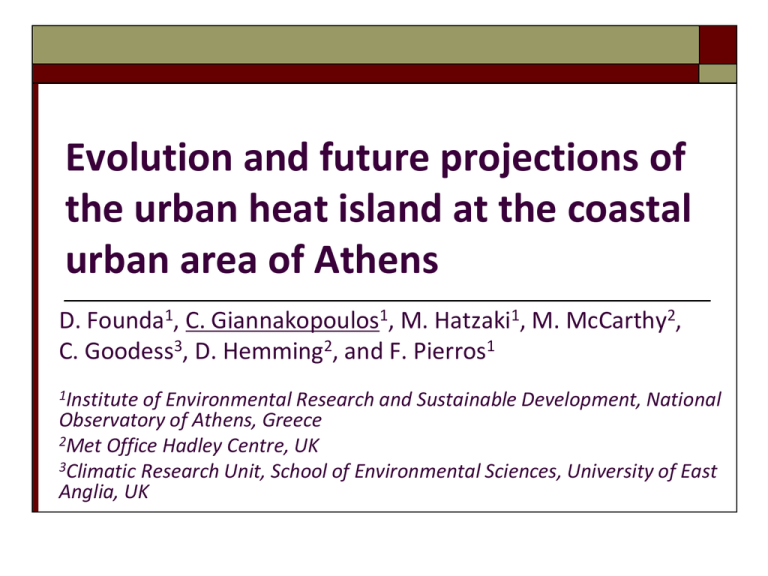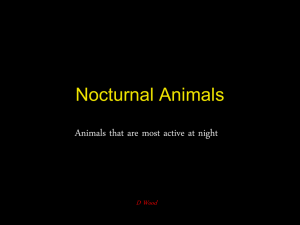urban heat island
advertisement

Evolution and future projections of the urban heat island at the coastal urban area of Athens D. Founda1, C. Giannakopoulos1, M. Hatzaki1, M. McCarthy2, C. Goodess3, D. Hemming2, and F. Pierros1 1Institute of Environmental Research and Sustainable Development, National Observatory of Athens, Greece 2Met Office Hadley Centre, UK 3Climatic Research Unit, School of Environmental Sciences, University of East Anglia, UK Air temperature trends in Athens •Athens is a large urban area of eastern Mediterranean that experiences both global warming and urbanization effects •According to the historical records of the National Observatory of Athens (NOA), the annual air temperature in Athens reveals a statistically significant positive trend from the beginning of the past century till now •This is due to the increase of the summer rather than the winter temperature •The increase of the maximum temperature in summer during the last few decades (since the mid 1970’s) is significantly large and amounts roughly to 1°C/decade •Summer 2007 was an exceptionally hot summer in Athens, with three severe heat waves and an all time record value in the maximum temperature (44.8°C at NOA)( Founda & Giannakopoulos 2009) •However, summer 2012 (June – August) was the warmest summer ever recorded at NOA as regards the mean maximum and minimum air temperature Mean summer temperature at NOA (1897-2010) 30 y = 0.02x - 4.61 Air temperature (C) 29 28 27 26 25 24 1890 1910 1930 1950 1970 1990 year Trends 1897-2010: + 0.16°C/decade, or ~ 1.8°C Trends 1976-2010: +0.9°C/decade, or ~ 3°C 2010 Mean winter temperature at NOA (1897-2010) 13 Air temperature 12 11 10 9 8 7 y = 0.0024x + 5.3508 6 1890 1910 1930 1950 1970 year Trends 1897-2010: +0.02°C/decade, or ~ 0.22°C Trends 1976-2010: +0.15°C/decade, or ~ 0.5°C 1990 2010 Global warming or urbanization? global climate responds to the radiative forcing and feedbacks resulting from emissions of greenhouse gases regional climates further respond to drivers as land-use change, agriculture, deforestation, and irrigation localised micro-climates can develop as a result of immediate human activity and settlements most apparent and widely known expression of this is the urban heat island (UHI) effect: measurably warmer urban areas than surrounding rural environments UHI intensity: reflected by temperature differences between urban and rural sites depends on the size, population and industrial development of a city, topography, regional climate and meteorological conditions Urban heat island should be considered on three different scales First, there is the mesoscale of the whole city Second is the local scale on the order of the size of a park Third scale is the microscale of the garden and buildings near the meteorological observing site Of the three scales the microscale and local-scale effects generally are larger than mesoscale effects Urban heat island in Athens – previous research UHI in Athens is of the order of 4-5°C between urban and suburban stations (Livada et al. 2005) But UHI can be of the order of 10°C between rural stations and the central zone of the city Significant research on spatial variability of UHI in Athens, but… •Studies concerning the rates of changes of UHI over time are missing •It is important to know whether the intensity of the urban heat island in the city continues to amplify, if it has moderated or has stabilized Selected Stations NOA ► urban in a park (unchanged environment local and microscale) Helliniko (HEL) ► urban coastal Tatoi (TAT) ► rural – suburban Tanagra (TAN) ► rural (airport) Aliartos (ALI) ► rural Elefsis (ELE) ► suburban (industrial) NOA represents the ‘background’ urban conditions in Athens on the mesoscale Summer maximum temperature NOA (urban) and HEL (coastal urban) stations 37 HEL max NOA max 36 35 y = 0.09x - 150.12 34 33 32 31 y = 0.10x - 168.62 30 29 28 1970 1975 1980 1985 1990 1995 Similar trends at NOA and HEL 2000 2005 2010 2015 Summer average, maximum and minimum temperatures at two urban and two rural stations 30 Summer average temperature 29 28 27 26 25 rura l 1 rura l 2 24 urba n1 urba n2 23 22 1975 1980 40 1985 1990 1995 2000 2005 Summer maximum and minimum tempearure 35 30 25 20 15 10 1975 rural1(max) urban1(max) 1980 rural1(min) urban1(min) 1985 1990 rural2(max) urban2(max) 1995 rural2(min) urban2(min) 2000 2005 Summer UHI Temporal Variation and Trends 1.6 1.2 NOA-TAN (avg) HEL-TAN(avg) UHI (Turban –Trural) y = 0.04x - 79.43 0.8 0.4 y = 0.04x - 79.99 0 -0.4 -0.8 1975 2.5 2 HEL-TAT(avg) NOA-TAT(avg) 1980 1985 1990 UHI (Turban – Tsuburban) 1995 2000 y = 0.02x - 41.38 1.5 1 0.5 y = 0.02x - 41.93 0 -0.5 1975 1980 1985 1990 1995 2000 2005 2005 Winter temperature at NOA (urban) and HEL (coastal urban) stations 13 y = -0.0005x + 11.589 winter temperature (C) 12 11 10 9 y = -0.0008x + 11.586 8 7 HEL avg NOA avg 6 1975 1980 1985 1990 1995 Similar trends (no statistical significant trend) 2000 2005 Winter UHI Trends UHI (Turban –Trural) 4 3 NOA-TAN avg HEL-TAN avg y = 0.02x - 37.87 2 y = 0.02x - 37.87 1 0 1975 1980 UHI (Turban –Trural) 1985 1990 1995 2000 2005 UHI (Turban – Tsuburban) 4 y = 0.01x - 17.95 3 2 y = 0.01x - 17.95 1 HEL-TAT avg NOA-TAT avg 0 1975 1980 1985 1990 1995 2000 2005 Results on Athens UHI temporal evolution Summer average air temperature trends after 1976 at two urban stations in Athens are of the order of 1°C/decade UHI in summer increases at a rate of the order of 0.4°C /decade (urban-rural) or 0.2°C/decade (urban-suburban) Roughly 60% of warming is due to global warming and the rest 40% is due to urban effect Winter average air temperature after 1976 at two urban stations in Athens reveal no significant trend. UHI in winter, increases at a rate of the order of 0.2°C/decade (urban-rural) or 0.1oC/decade (urban-suburban). Model simulations A novel climate model that includes a sub-grid urban land-surface model was applied for an integrated impacts assessment for the Athens urban case study ► in order to quantify the cumulative impact and relative importance of climate change and urban heat island to the exposure of urban populations to temperature extremes as it is essential to consider the combined role of global warming and local urban warming Urban Heat Island Simulations Urban fraction is set HadRM3 modified to include to zero MOSES 2.2 land-surface scheme and urban parameterisation ► “tiled” surface The "tiles" allow sub-grid variations Nine extracted gridcells over and Fully coupled surrounding the tree cities urban 1971-1990 2041-2060 NoUrbNoAnth - UrbNoAnth UrbNoAnth UrbAnth UrbAnth - Urb3Anth model H H H Fully coupled urban H model including T additional T As UrbAnth, but with anthropogenic term Surface tile scheme, tripled anthropogenic T representing land surface heat flux T exchanges within a single model gridcell 1 2 3 4 2 1 3 4 Urban Heat Island Simulations – gridcells 39 38.5 38 37.5 22.5 Gridcells organised as: 123 456 789 cell 5 represents the city centre location and 1,2,3,4,6,7,8,9 are surrounding 23 1 2 3 4 7 5 6 8 9 23.5 24 24.5 25 Climate model bias •Larger RMSE for coastal points than for neighboring inland points, suggesting coastal influence on the apparent model bias Urban Tile Temperatures - Athens 40 Tmin 30 NoUNoA 25 35 UNoA UA 20 Tmax NoUNoA NOA UNoA 30 UA 25 NOA 20 15 15 10 10 5 5 0 0 0 2 4 6 8 10 0 12 Tmin 2 2.5 2 1.5 0 2 4 6 8 10 12 8 10 12 Tmax NoUNoA UNoA UA 0.5 0 -2 -0.5 0 -3 NoUNoA -5 6 1 -1 -4 4 3 1 0 2 UNoA UA RMSE 2.44 2.09 1.74 2 4 6 8 10 12 -1 -1.5 -2 -2.5 RMSE 1.50 1.54 1.49 Intra-annual cycle of Tmin and Tmax (upper panels) for NoUrbNoAnth, UrbNoAnth, UrbAnth simulations and observations and the differences (lower panels) between simulations and observations, using urban tile temperatures, between 1971-1990. Gridcell mean temperatures - Athens 25.00 NoUrbNoAnth 20.00 40.00 Tmin NoUrbNoAnth UrbNoAnth 35.00 UrbNoAnth UrbAnth 30.00 UrbAnth NOA Tmax NOA 25.00 15.00 20.00 10.00 15.00 10.00 5.00 5.00 0.00 3.00 0.00 0 2 4 6 8 10 12 4.00 2.00 0 2 4 6 8 10 12 0 2 4 6 8 10 12 3.00 1.00 2.00 0.00 -1.00 0 2 4 6 8 10 12 1.00 -2.00 0.00 -3.00 -4.00 NoUrbNoAnth -5.00 UrbNoAnth -6.00 UrbAnth RMSE 4.34 2.74 2.42 -1.00 NoUrbNoAnth -2.00 -3.00 UrbNoAnth UrbAnth RMSE 1.48 1.51 1.39 Intra-annual cycle of Tmin and Tmax (upper panels) for NoUrbNoAnth, UrbNoAnth, UrbAnth simulations and observations and the differences (lower panels) between simulations and observations, using gridcell mean temperatures, between 1971-1990. Urban model bias – Athens case greatest impact of anthropogenic waste heat on the UHI during winter gridcell-5 3 2.5 2 1.5 during summer, it becomes a small term relative to the solar forcing 1 UrbAnth-NoUrbNoAnth 0.5 UrbNoAnth-NoUrbNoAthn 0 0 2 4 6 8 10 12 5 Model evaluation 23 1 2 3 4 7 5 6 8 9 23.5 24 24.5 25 Summer Daytime/Nocturnal UHI UHIurban-rural UHIurban-rural daytime nocturnal daytime nocturnal daytime nocturnal obs 0.16 4.55 obs 0.16 4.55 obs 0.16 4.55 NoUrbNoAnth 1.14 2.72 UrbNoAnth 1.06 4.57 UrbAnth 1.07 4.75 RMSE 0.98 1.83 RMSE 0.9 0.02 RMSE 0.91 0.2 UHIurban-suburban daytime nocturnal daytime nocturnal daytime nocturnal obs 0.59 3.77 obs 0.59 3.77 obs 0.59 3.77 NoUrbNoAnth 1.07 0.45 UrbNoAnth 1.16 2.21 UrbAnth 1.13 2.39 RMSE 0.48 3.32 RMSE 0.57 1.56 RMSE 0.54 1.38 daytime nocturnal daytime nocturnal daytime nocturnal obs 0.55 4.39 obs 0.55 4.39 obs 0.55 4.39 NoUrbNoAnth 0.71 2.00 UrbNoAnth 0.71 3.93 UrbAnth 0.77 4.11 RMSE 0.16 2.39 RMSE 0.16 0.46 RMSE 0.22 0.28 Winter Daytime/Nocturnal UHI UHIurban-rural UHIurban-rural daytime nocturnal daytime nocturnal daytime nocturnal obs 1.50 3.50 obs 1.50 3.50 obs 1.50 3.50 NoUrbNoAnth 1.38 -0.07 UrbNoAnth 1.44 1.69 UrbAnth 1.51 1.99 RMSE 0.12 3.57 RMSE 0.06 1.81 RMSE 0.01 1.51 UHIurban-suburban daytime nocturnal daytime nocturnal daytime nocturnal obs 1.40 3.00 obs 1.40 3.00 obs 1.40 3.00 NoUrbNoAnth 0.38 0.67 UrbNoAnth 0.45 1.94 UrbAnth 0.5 2.13 RMSE 1.02 2.33 RMSE 0.95 1.06 RMSE 0.90 0.87 daytime nocturnal daytime nocturnal daytime nocturnal obs 1.20 3.40 obs 1.20 3.40 obs 1.20 3.40 NoUrbNoAnth 0.77 -1.09 UrbNoAnth 0.81 0.68 UrbAnth 0.87 1.04 RMSE 0.43 4.49 RMSE 0.39 2.72 RMSE 0.33 2.36 Future Projections of UHI for summer UHIurban-rural UHIurban-rural UrbNoAnth daytime 0.97 nocturnal 4.67 UrbAnth daytime 1.05 nocturnal 4.66 Urb3Anth daytime 1.12 nocturnal 5.16 % -8.5 2.2 -1.9 -1.9 4.7 11.0 UHIurban-suburban daytime nocturnal daytime nocturnal daytime nocturnal UrbNoAnth 1.14 2.17 UrbAnth 1.17 2.29 Urb3Anth 1.27 2.72 % -1.7 -1.8 3.5 -4.2 11.4 18.3 daytime nocturnal daytime nocturnal daytime nocturnal UrbNoAnth 0.83 4.40 UrbAnth 0.75 4.18 Urb3Anth 0.86 4.69 % 16.9 12.0 -2.6 1.7 16.2 16.7 Future Projections of UHI for winter UHIurban-rural UHIurban-rural UrbNoAnth daytime 0.97 nocturnal 4.67 UrbAnth daytime 1.05 nocturnal 4.66 Urb3Anth daytime 1.12 nocturnal 5.16 % -8.5 2.2 -1.9 -1.9 4.7 11.0 UHIurban-suburban daytime nocturnal daytime nocturnal daytime nocturnal UrbNoAnth 0.41 1.99 UrbAnth 0.52 2.15 Urb3Anth 0.65 2.46 % -8.9 2.6 4.0 0.9 38.3 21.8 daytime nocturnal daytime nocturnal daytime nocturnal UrbNoAnth 1.09 1.26 UrbAnth 0.88 0.95 Urb3Anth 1.06 1.52 % 34.6 85.3 1.1 -8.7 26.2 90.0 Model Results The analysis of the influence of the urban land surface and urban anthropogenic heat emissions for Athens showed that: the main characteristics of a Mediterranean UHI captured by a simple urban surface exchange scheme, when compared observational data for Athens temperature changes in response to an SRES A1B scenario by the 2050s are similar for urban and nonurban surfaces future climate change will affect the urban and rural areas as well future UHI responds to changes in the additional driver of anthropogenic heat emissions of a city Thank you for your attention! The model simulations were performed within the context of EU-FP6 project CIRCE Integrated Project-Climate Change and Impact Research: the Mediterranean Environment (http://www.circeproject.eu).






